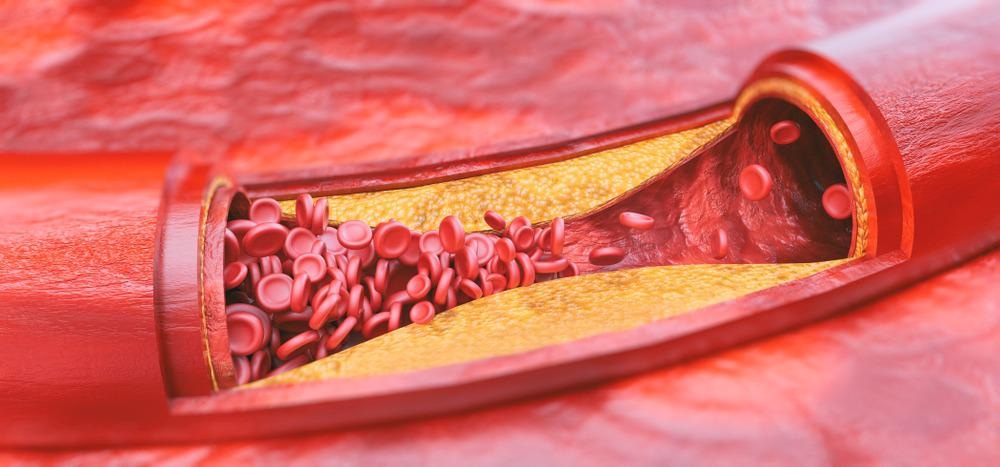In a recent article published in the journal Applied Materials Today, the authors conducted a systematic review of current trends in nanomaterials-based therapeutic strategies, including disease diagnosis, drugs, and surgical therapies, against atherosclerosis (AS).

Study: New insights to atherosclerosis management: Role of nanomaterials. Image Credit: Crevis/Shutterstock.com
Here, the clinical progress in the use of nanomaterials in AS management was highlighted, offering key insights into the future scope for the development of novel nanomaterials-based diagnosis and disease management.
Conventional AS Management
AS is a chronic inflammatory disease caused by lipoprotein accumulation in the walls of blood vessels. Current interventions and drug treatments for curing AS have their drawbacks, including serious side effects and lack of efficiency, majorly due to the lack of target specificity and bioavailability. Nanomaterials can be a solution to overcome these drawbacks and have great scope in AS diagnosis, treatment, and monitoring.
Nanomaterial-Based AS Drug Therapy
Generally, AS drugs are classified based on AS pathogenesis. Abnormally regulated inflammatory pathways are the main cause of AS, thus making the inflammatory disorders the primary targets for AS treatment. To enhance target specificity, several nanodrugs have been developed.
Some examples include spherical high-density lipoprotein (HDL)-like nanoparticles (NPs) that deliver HDL at the site of inflammation, gene-based monocyte-C18PGQDs-miR223 architecture that can effectively deliver miR223 into plaque’s interior, and single-walled nanotube (SWNT)-SHP1 that regulate inflammation at the target site.
Another cause of AS is the invasion of lipid-loaded macrophages or AS lesions under the endothelium. To this end, pre-clinical studies on docetaxel-loaded lipid core NPs (LDE-DTX) have shown anti-inflammatory and anti-proliferative therapeutic efficiency in AS management.
Antioxidants used to treat the unregulated production of reactive oxygen species (ROS) caused by an unhealthy lifestyle also led to AS development. To treat this, nanoenzyme-based antioxidant therapy is a promising tool.
For instance, rapamycin-encapsulated acetylated β-cyclodextrin NPs, SOD1-loaded polyketal particles, and coenzyme Q10-loaded poly(lactic-co-glycolic acid) NPs increase the bioavailability of the drug at the target site and reduce cellular superoxide levels. Additionally, Tempol and phenylboronic acid pinacol ester-loaded cyclic polysaccharide β-cyclodextrin NPs inhibit foam cell formation, thus reducing systemic and local oxidative stress.
Furthermore, endothelial cell dysfunction caused by shear stress alters the blood vessel’s permeability leading to the development of localized plaques in AS. Hence, the areas with disturbed blood flows are a common sight in AS plaques.
In this context, antisense oligonucleotide-based anti-miRNA therapeutic nanodrugs are used as potential treatment tools. In addition, hyaluronic acid (HA) polymer consisting of N-acetylglucosamine and β-glucuronic acid has been found to reduce macrophages and thus inflammation at the plaque site. Sugar-based amphiphilic NPs have also shown anti-AS properties by effectively immobilizing lipid-rich lesions.
Nanomaterials-Based AS Management: Surgical Therapy and Diagnosis
Percutaneous coronary intervention (PCI) and stent treatment for coronary artery disease (CAD) generally result in restenosis (artery blockage) causing AS. To prevent this, nanotechnology-based anti-inflammatory and anti-proliferative drugs have been used in treating CAD. Also, paclitaxel-loaded magnetic NPs and gold nanowire-incorporated alginate scaffolds were reported as effective strategies for combating stent restenosis.
In addition, coronary artery bypass grafting, affected by intimal hyperplasia of vein grafts, due to large inner pore-sized synthetic vascular grafts, can also lead to blood vessel blockage and AS. To tackle this, Antheraea assama silk-based vascular graft and nano-tissue (a blend of synthetic grafts and low molecular weight polymers) can be used to reduce blockage and enhance the anti-thrombic property.
Further, functionalized nanomaterials can efficiently target and recognize disease markers for disease diagnosis. Techniques such as sarcomere length nanometry for behavioral analysis, fluorescent CdSe@ZnS semiconductor for plaque tracing, near-infrared quantum dots (NIR-QDs) for thermal sensing, antibody-functionalized gold nanoprobes for the identification and quantification of intercellular vascular inflammation have proven that fluorescence imaging techniques can aid in understanding vascular physiology and pathogenesis.
NP-based magnetic resonance imaging (NPMRI) has enabled researchers to study the pharmacokinetic properties of drugs and monitor corresponding vascular inflammation. Additionally, the combination of positron emission tomography (PET) and computed tomography (CT) can image the whole body, thus contributing to inflammatory response identification in AS management.
Furthermore, PET and CT nanomaterial-based imaging tools provide good spatial resolution and excellent sensitivity necessary for in vivo and clinical studies. Ultimately, the development of nanotechnology-based, highly sensitive sensors resulted in their low concentration requirements, quick response, and broader recognition range, providing a greater advantage for efficient imaging and treatment.
Clinical Research on Nanomaterials-Based AS Management - Limitations
Although several nanomaterials were studied in the current review for therapy and diagnosis of AS, many of them have limited human application. This is because the clinical trials use mouse models whose results cannot be entirely simulated in a human trial.
Efficient drug storage and stability is another limitation affecting the comprehensive study of disease development. Finally, a lack of good manufacturing practice and commercialization hampers progression to clinical products from basic research.
Conclusion
This review shows that nanomaterial-based AS management has the potential to revolutionize AS diagnosis and treatment. However, the biggest challenge in the commercialization of NP-based therapeuftic and diagnostic agents is their escalation to clinical application.
The scope of NP use lies in the detailed study of molecular interaction of targeted nanosystems in AS developmental studies. Thus, contributing to the design and development of AS-targeting nanosystems and transforming them into clinical applications is crucial to achieving successful strategies for early detection and treatment.
Reference
Li, Z., Jiang, (2022) New insights to atherosclerosis management: Role of nanomaterials. Applied Materials Today, 27, p.101466. https://www.sciencedirect.com/science/article/abs/pii/S2352940722001056
Disclaimer: The views expressed here are those of the author expressed in their private capacity and do not necessarily represent the views of AZoM.com Limited T/A AZoNetwork the owner and operator of this website. This disclaimer forms part of the Terms and conditions of use of this website.